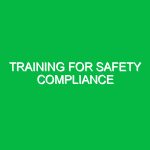In today’s rapidly evolving work landscape, the concept of Workplace Safety Innovations has become paramount. These innovations not only address existing hazards but also anticipate future risks, enhancing the overall health, safety, and environment (HSE) strategies within organizations. Workplace Safety Innovations encompass new technologies, methodologies, and practices aimed at preventing accidents, reducing risks, and ensuring a safe working environment for all employees. This article delves into the significance of these innovations, the potential hazards they address, safety precautions to implement, and the regulations governing them.
The Importance of Workplace Safety Innovations
The relevance of Workplace Safety Innovations cannot be overstated. With the increasing complexity of workplaces and the introduction of advanced technologies, the risks associated with occupational health and safety have also escalated. In sectors like construction, manufacturing, and healthcare, the potential for accidents is significant. Innovations in workplace safety not only protect employees but also enhance productivity, reduce costs associated with workplace injuries, and foster a culture of safety within organizations.
For instance, consider the implementation of wearable technology in a construction setting. Workers equipped with smart helmets can receive real-time alerts about potential hazards like structural weaknesses or toxic gas exposure. This proactive approach not only safeguards employees but also instills a sense of confidence among the workforce. When workers feel safe, they are more likely to perform at their best.
Identifying Hazards and Risks in the Workplace
Understanding the hazards and risks associated with workplace safety is crucial for effectively implementing innovations. Hazards can be categorized into several types:
Physical Hazards
These are perhaps the most recognizable forms of hazards. They include slips, trips, falls, and injuries from machinery. According to the Occupational Safety and Health Administration (OSHA), slips and falls account for a significant percentage of workplace injuries. Implementing safety innovations, such as non-slip flooring and advanced machinery with built-in safety features, can significantly reduce these risks.
Chemical Hazards
Exposure to hazardous chemicals is another critical concern. Workers in industries like manufacturing and healthcare often face risks from toxic substances. Innovations like closed-system chemical transfer methods can minimize exposure and ensure safer handling practices. Moreover, utilizing real-time monitoring systems can alert workers to hazardous air quality changes.
Ergonomic Hazards
With the increasing prevalence of office jobs, ergonomic hazards have become a pressing issue. Poor workstation design can lead to musculoskeletal disorders (MSDs). Recent innovations in adjustable furniture and ergonomic tools help employees maintain proper posture, reducing the risk of injury. For example, sit-stand desks allow employees to alternate between sitting and standing, promoting better physical health.
Psychosocial Hazards
While often overlooked, psychosocial hazards such as workplace stress and harassment can significantly impact employee well-being. Innovations in mental health support, such as employee assistance programs (EAPs) and mental health awareness training, are vital in addressing these risks. Creating an environment where employees feel valued and supported fosters a positive workplace culture.
Best Practices and Safety Precautions
Implementing best practices related to Workplace Safety Innovations is essential for maximizing their effectiveness. Here are some actionable steps organizations can take:
Regular Training and Education
Continual training is fundamental. Employees should receive regular training on the latest safety protocols and innovations, ensuring they are equipped to use new technology effectively. For instance, a manufacturing plant might conduct quarterly training sessions on the safe use of automated machinery, reinforcing the importance of adhering to guidelines.
Conducting Risk Assessments
Regular risk assessments allow organizations to identify potential hazards and implement appropriate safety measures. These assessments should be comprehensive, considering all aspects of the workplace. For example, a risk assessment in a warehouse might reveal the need for better signage to alert workers to potential hazards, leading to the installation of clear, visible warnings in high-risk areas.
Utilizing Technology
Embracing technological advancements can significantly enhance workplace safety. For instance, drones are increasingly used in construction to survey sites and identify hazards without putting workers at risk. Additionally, artificial intelligence (AI) can analyze data from previous incidents to predict and mitigate future risks. Organizations should actively seek out and invest in these innovations.
Encouraging Open Communication
Fostering an environment where employees feel comfortable reporting hazards or suggesting improvements is crucial. Regular safety meetings can provide a platform for open dialogue. For example, one organization implemented a “safety suggestion box,” allowing employees to anonymously submit concerns or ideas for safety innovations. This initiative not only improved safety measures but also empowered employees, enhancing overall morale.
Regulations and Standards Governing Workplace Safety Innovations
Adhering to regulations and standards is a critical aspect of implementing Workplace Safety Innovations. Various organizations set forth guidelines to ensure safe working conditions. In the United States, OSHA provides regulatory frameworks that organizations must comply with to protect workers. Similarly, the National Institute for Occupational Safety and Health (NIOSH) conducts research and makes recommendations for preventing work-related injuries and illnesses.
Internationally, standards set by the International Organization for Standardization (ISO), such as ISO 45001, focus on occupational health and safety management systems. Compliance with these standards not only safeguards employees but also enhances an organization’s credibility and reputation.
Case Studies of Successful Innovations in Workplace Safety
Real-world examples of successful Workplace Safety Innovations can provide valuable insights into how these strategies can be effectively implemented.
Case Study 1: The Construction Industry
A construction company in Texas adopted wearable technology in its workforce. Each worker wore a smart device that monitored vital signs and environmental conditions. If a worker’s heart rate exceeded a safe threshold or if they entered a hazardous area, alerts were sent out immediately. This innovation resulted in a 30% decrease in heat-related illnesses on site. The proactive approach not only safeguarded workers but also reduced downtime and increased productivity.
Case Study 2: Manufacturing Sector
In a large manufacturing facility in Ohio, AI-driven analytics were employed to enhance safety protocols. By analyzing historical data on workplace accidents, the system identified patterns and potential hazards. As a result, the company implemented targeted training programs and made necessary changes to equipment layout, leading to a significant reduction in workplace injuries. This innovative approach reinforced the importance of data-driven decision-making in improving safety.
The Future of Workplace Safety Innovations
As we look to the future, the role of Workplace Safety Innovations will only continue to grow. With the advent of technologies such as augmented reality (AR) and virtual reality (VR), training and hazard identification will become more interactive and effective. For instance, VR simulations can immerse employees in realistic scenarios, allowing them to practice safety protocols in a controlled environment.
Moreover, as remote work becomes more prevalent, organizations must adapt safety innovations to ensure the well-being of employees working from home. This may involve providing ergonomic assessments and mental health resources to support remote workers.
Conclusion
Workplace Safety Innovations are not just a trend; they are an essential component of modern organizational practices. By identifying and addressing potential hazards, implementing best practices, and adhering to regulations, businesses can create safer environments for their employees. As we embrace new technologies and methodologies, the commitment to workplace safety must remain a priority. Investing in safety innovations is not just a legal obligation; it is a moral imperative that reflects an organization’s dedication to its most valuable asset—its people.


